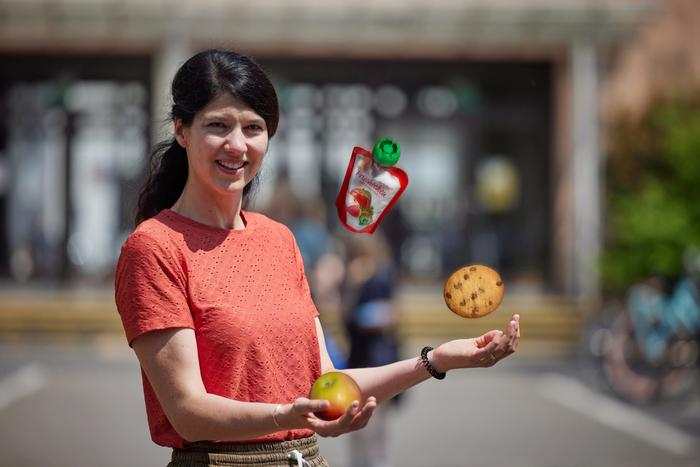Would third- and fourth-graders buy fewer unhealthy snacks if they were more expensive? The answer provided by researchers at the University of Bonn is nuanced: Some elementary school students do actually pay attention to the price. Others, however, have such strong preferences that they are willing to pay a little more for them. A third group, in contrast, does not yet seem to have sufficient cognitive skills to be significantly influenced by prices. The study illustrates above all how differently children behave when it comes to their snack purchases – a finding that should also be of interest to policymakers. The results have now been published in the journal Food Quality and Preference.

Credit: Assembly: Volker Lannert/University of Bonn
Would third- and fourth-graders buy fewer unhealthy snacks if they were more expensive? The answer provided by researchers at the University of Bonn is nuanced: Some elementary school students do actually pay attention to the price. Others, however, have such strong preferences that they are willing to pay a little more for them. A third group, in contrast, does not yet seem to have sufficient cognitive skills to be significantly influenced by prices. The study illustrates above all how differently children behave when it comes to their snack purchases – a finding that should also be of interest to policymakers. The results have now been published in the journal Food Quality and Preference.
Should I go for the chocolate cookies or maybe the apple slices? Even elementary school children are faced with this decision: The purchasing power of six- to twelve-year-olds in Germany is estimated at more than two billion euros. Many of them invest much of their pocket money in ice cream and other sweet treats. But frequently reaching for unhealthy snacks can have long-term consequences: One in seven children in Germany is considered overweight. At the same time, the number of those who develop diabetes or suffer from cardiovascular problems at a young age is increasing.
“In countries like Great Britain, a sugar tax is now levied on sweet drinks,” explains Stefanie Landwehr, a doctoral student at the Chair for Agricultural and Food Market Research at the University of Bonn. This measure also seems to be successful with teenagers, as studies suggest. But is this also the case with younger children? And in comparison, what influence do certain brands that are popular in the age group have on the purchase decision?
Cookie, fruit pulp or apple slices?
Landwehr investigated these questions together with Prof. Dr. Monika Hartmann, chair of the department, as well as Prof. Sean B. Cash (Tufts University Boston, USA) and Dr. Ching-Hua Yeh (University of Bonn). The researchers were able to recruit around 120 elementary school students between the ages of seven and ten as test subjects. The young participants were first asked to answer a few questions, such as about their favorite snacks and their knowledge of nutrition. They also completed a simple test on their understanding of quantities. Sample question: If there are 50 children at a children’s birthday party, is that a lot or a little? “The results allow conclusions to be drawn about how well children can evaluate numbers,” Landwehr explains. “Those who have lower skills in this regard are probably less able to assess prices.”
After completing this part, the girls and boys received three euros as a reward. They were then able to buy a snack as part of a simple purchase experiment. The assortment included a chocolate chip cookie (the unhealthiest alternative), a squeeze pack with fruit pulp (slightly healthier), and apple slices (the healthiest choice). The products were offered at three different price levels – 60 cents, one euro or 1.40 euros. In addition, each snack came in two varieties: one from McDonald’s, a very well-known brand among children, and a second from an unknown manufacturer.
Now the children were shown photos of two different products at different prices, such as a no-name chocolate cookie for one euro and apple slices from McDonald’s for 1.40 euros. The girls and boys could state which product they would buy, but also had the option of choosing neither. The choice was noted on a response card. In total, this experiment was repeated ten times with different snack and price combinations. “So we ended up with ten report cards for each child,” explains Prof. Monika Hartmann. These were turned over and shuffled, and the respective child was allowed to draw a card. The choice ticked on it was then implemented: For example, if the card was drawn where the child chose a no-name chocolate cookie for the price of one euro, the child paid and received the cookie.
Cookie fans do not look at the price
Analysis of the data shows that elementary school kids varied widely in their purchase decisions. “In general, they could be divided into three groups,” Landwehr says. The cookie lovers who could not be dissuaded from buying their favorite snack even if it was more expensive. The price-sensitive shoppers, who made their decision primarily dependent on the purchase price. And those who did not yet have a clear understanding of cheap or expensive – these were mostly the younger ones. They often tended to choose the fruit pulp; the price did not matter much to them.
Somewhat surprising for the researchers was another result: McDonald’s snacks were by no means more popular with the children. On the contrary: On average, they were actually less willing to pay for them than for snacks from unknown manufacturers. “It may be because McDonald’s is known more for its burgers and fries and less for apple slices or chocolate cookies,” Landwehr speculates. It is quite possible that other brands may well have an effect on children’s consumption decisions, she says.
Overall, the study shows that younger children are a very heterogeneous target group: Measures aimed at steering their consumption behavior in a certain direction do not work equally for everyone. “For instance, age and understanding of ‘cheap’ or ‘expensive’ plays a significant role in the impact of price signals,” Landwehr explains. “However, there are children who have such an understanding but are still unlikely to be influenced by higher prices. In the fight against obesity, it therefore makes sense to rely on a variety of strategies to reach as many girls and boys as possible.”
Participating institutions and funding:
In addition to the University of Bonn, Tufts University Boston (USA) was also involved in the study. The work was funded by the German Research Foundation (DFG).
Publication: Stefanie C. Landwehr, Monika Hartmann, Sean B. Cash, Ching-Hua Yeh: The kids are not all the same – Heterogeneity in children’s snack purchase behavior. Food Quality and Preference, DOI: https://doi.org/10.1016/j.foodqual.2023.104906
Media contact:
Stefanie Landwehr
Market Research in the Agricultural and Food Industry
Institute for Food and Resource Economics (ILR)
University of Bonn
Tel. +49 228 732139
Email: [email protected]
DOI
10.1016/j.foodqual.2023.104906
Method of Research
Experimental study
Subject of Research
People
Article Title
The kids are not all the same – Heterogeneity in children’s snack purchase behavior.
Article Publication Date
1-Jun-2023




